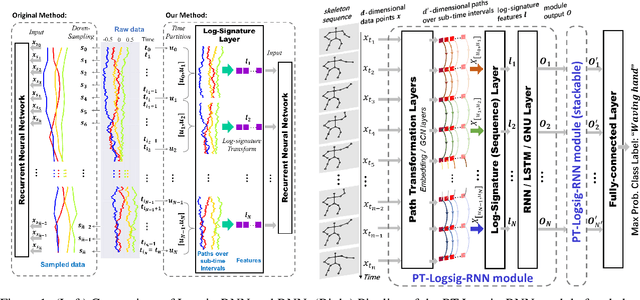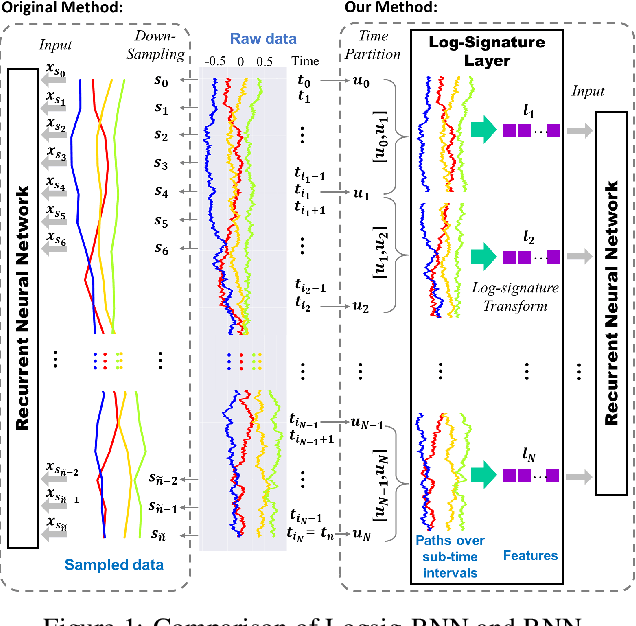Shujian Liao
Forex Trading Volatility Prediction using Neural Network Models
Dec 03, 2021



Abstract:In this paper, we investigate the problem of predicting the future volatility of Forex currency pairs using the deep learning techniques. We show step-by-step how to construct the deep-learning network by the guidance of the empirical patterns of the intra-day volatility. The numerical results show that the multiscale Long Short-Term Memory (LSTM) model with the input of multi-currency pairs consistently achieves the state-of-the-art accuracy compared with both the conventional baselines, i.e. autoregressive and GARCH model, and the other deep learning models.
Sig-Wasserstein GANs for Time Series Generation
Nov 01, 2021



Abstract:Synthetic data is an emerging technology that can significantly accelerate the development and deployment of AI machine learning pipelines. In this work, we develop high-fidelity time-series generators, the SigWGAN, by combining continuous-time stochastic models with the newly proposed signature $W_1$ metric. The former are the Logsig-RNN models based on the stochastic differential equations, whereas the latter originates from the universal and principled mathematical features to characterize the measure induced by time series. SigWGAN allows turning computationally challenging GAN min-max problem into supervised learning while generating high fidelity samples. We validate the proposed model on both synthetic data generated by popular quantitative risk models and empirical financial data. Codes are available at https://github.com/SigCGANs/Sig-Wasserstein-GANs.git.
Logsig-RNN: a novel network for robust and efficient skeleton-based action recognition
Nov 01, 2021



Abstract:This paper contributes to the challenge of skeleton-based human action recognition in videos. The key step is to develop a generic network architecture to extract discriminative features for the spatio-temporal skeleton data. In this paper, we propose a novel module, namely Logsig-RNN, which is the combination of the log-signature layer and recurrent type neural networks (RNNs). The former one comes from the mathematically principled technology of signatures and log-signatures as representations for streamed data, which can manage high sample rate streams, non-uniform sampling and time series of variable length. It serves as an enhancement of the recurrent layer, which can be conveniently plugged into neural networks. Besides we propose two path transformation layers to significantly reduce path dimension while retaining the essential information fed into the Logsig-RNN module. Finally, numerical results demonstrate that replacing the RNN module by the Logsig-RNN module in SOTA networks consistently improves the performance on both Chalearn gesture data and NTU RGB+D 120 action data in terms of accuracy and robustness. In particular, we achieve the state-of-the-art accuracy on Chalearn2013 gesture data by combining simple path transformation layers with the Logsig-RNN. Codes are available at https://github.com/steveliao93/GCN_LogsigRNN.
Conditional Sig-Wasserstein GANs for Time Series Generation
Jun 09, 2020



Abstract:Generative adversarial networks (GANs) have been extremely successful in generating samples, from seemingly high dimensional probability measures. However, these methods struggle to capture the temporal dependence of joint probability distributions induced by time-series data. Furthermore, long time-series data streams hugely increase the dimension of the target space, which may render generative modeling infeasible. To overcome these challenges, we integrate GANs with mathematically principled and efficient path feature extraction called the signature of a path. The signature of a path is a graded sequence of statistics that provides a universal description for a stream of data, and its expected value characterizes the law of the time-series model. In particular, we a develop new metric, (conditional) Sig-$W_1$, that captures the (conditional) joint law of time series models, and use it as a discriminator. The signature feature space enables the explicit representation of the proposed discriminators which alleviates the need for expensive training. Furthermore, we develop a novel generator, called the conditional AR-FNN, which is designed to capture the temporal dependence of time series and can be efficiently trained. We validate our method on both synthetic and empirical datasets and observe that our method consistently and significantly outperforms state-of-the-art benchmarks with respect to measures of similarity and predictive ability.
Learning stochastic differential equations using RNN with log signature features
Sep 22, 2019



Abstract:This paper contributes to the challenge of learning a function on streamed multimodal data through evaluation. The core of the result of our paper is the combination of two quite different approaches to this problem. One comes from the mathematically principled technology of signatures and log-signatures as representations for streamed data, while the other draws on the techniques of recurrent neural networks (RNN). The ability of the former to manage high sample rate streams and the latter to manage large scale nonlinear interactions allows hybrid algorithms that are easy to code, quicker to train, and of lower complexity for a given accuracy. We illustrate the approach by approximating the unknown functional as a controlled differential equation. Linear functionals on solutions of controlled differential equations are the natural universal class of functions on data streams. Following this approach, we propose a hybrid Logsig-RNN algorithm that learns functionals on streamed data. By testing on various datasets, i.e. synthetic data, NTU RGB+D 120 skeletal action data, and Chalearn2013 gesture data, our algorithm achieves the outstanding accuracy with superior efficiency and robustness.
 Add to Chrome
Add to Chrome Add to Firefox
Add to Firefox Add to Edge
Add to Edge